Closed Loop AIO Liquid Coolers: 14-way Mega Roundup Review
by E. Fylladitakis on February 12, 2014 7:00 AM ESTTesting Results, Maximum Fan Speed (12V)
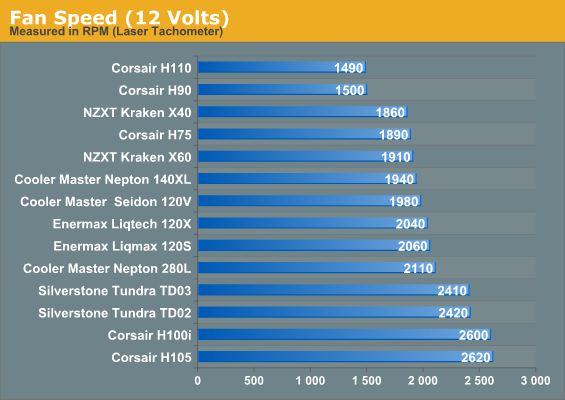
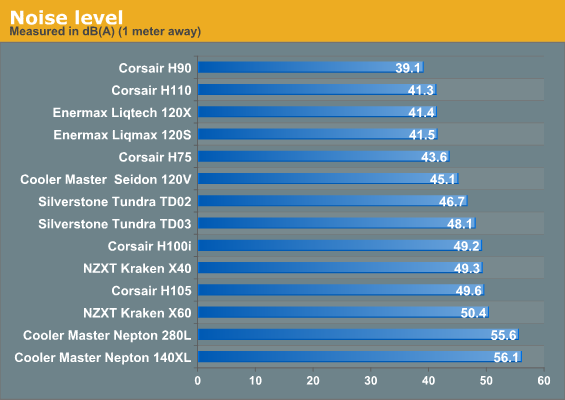
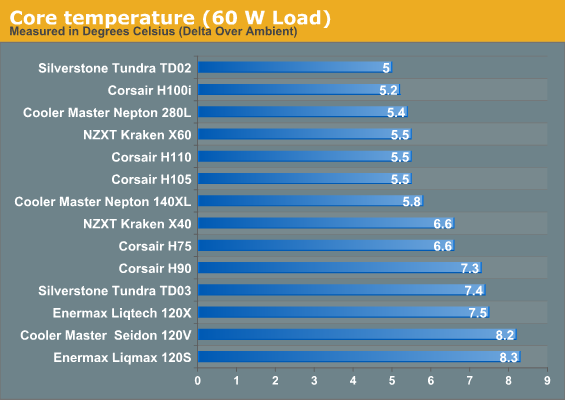
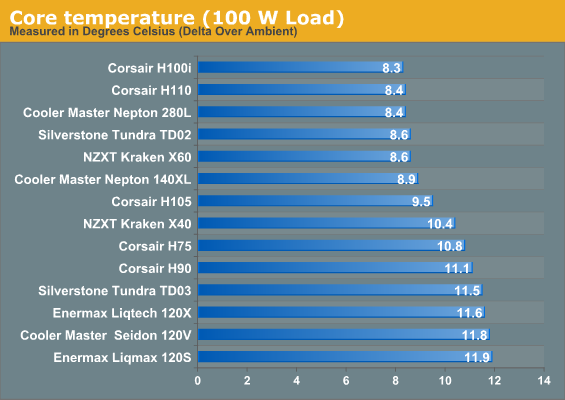
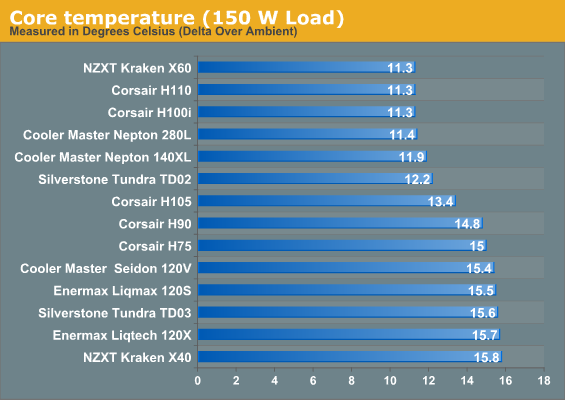
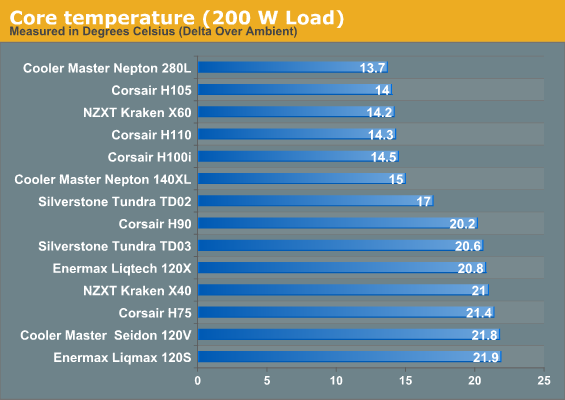

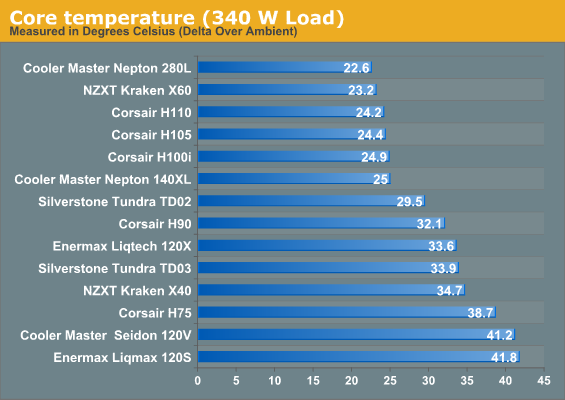

The above charts depict exactly why a user needs to be more than just a little careful when selecting a cooler. Even though they appear similar and some of them even nearly identical, the performance of each and every AIO cooler that we have tested varies greatly. For instance, Cooler Master obviously sought to provide the best heavy-load performance possible and they did manage to reach the top of our charts; however, the noise of the fans that Cooler Master supplied at maximum speed is intolerable for daily use by any standards.
To give you a rough estimate, 56 dB(A) represents about the same level of sound as a typical box fan the same distance. The Nepton 280L is closely followed by the NZXT Kraken X60 and then the Corsair H110, both of which share about the same size and design but not nearly the same noise levels. The NZXT Kraken X60 is over 5 dB(A) quieter than the Nepton 280L, a very perceptible difference, while the Corsair H110 generates only 41.3 dB(A), which is equivalent to a soft humming noise and fairly comfortable for daily use.
Naturally, the performance decreases as we move to AIO coolers with smaller radiators, with the Corsair H100i leading the coolers using 120mm fans but its stock fans run at 2600 RPM, generating high noise levels. The Enermax Liqtech 120X and Silverstone Tundra TD03 and their beefy radiators deliver great thermal performance when compared to other single-fan AIO coolers, although Enermax proved that they could offer roughly the same performance with just one fan and much lower noise levels, making Silverstone's choice to include two fans appear somewhat redundant.
Under a low thermal load however, the charts shift greatly. As the thermal load is much lower, the low temperature dissipation efficiency of the cooler now matters a lot more than its maximum thermal load capacity. Corsair's H100i offers the best thermal performance, outperforming coolers with significantly larger radiators, including Corsair's own H110, closely followed by another 240mm long cooler, the Silverstone Tundra TD02. The gap between the budget-level and high-performance products now closes, with the Corsair H75 being the most notable example, as it manages to outperform its own larger version, the H105. Apparently, bigger is not always better and the lower flow resistance of the single fan radiator gives the Corsair H75 a faster energy transfer rate at lower temperature deltas.










139 Comments
View All Comments
faster - Wednesday, February 12, 2014 - link
I want a closed loop system for my video card!My GTX780 is much louder than my CPU fan.
Liquid cooling was supposed to be how one obtained high performance quiet computing. Air cooling solutions should not be able to compete with a liquid cooling solution in the same environment, but it seems they do. How is that?
blanarahul - Wednesday, February 12, 2014 - link
"I want a closed loop system for my video card!"This. All the stupid OEMs want to disgruntle consumers. We already have more than enough great CPU coolers, but very few great GPU coolers. All I want is a card that is NOT pre-overclocked (but can be overclocked at my whims ;) ) and comes with a all-in-one liquid cooling solution. Is that too much to ask??
E.Fyll - Wednesday, February 12, 2014 - link
Oh, that is coming, soon. Stay tuned, should be online within a couple of weeks. :)Dribble - Wednesday, February 12, 2014 - link
True, for cpu's you don't need that big a cooler - all these lower power Intel cpu's don't pull 200W even overclocked. A big air cooler is sufficient. It'll work as well as a single 120mm fan radiator water cooler but is cheaper and more reliable.However graphics cards are another matter altogether - they pump out huge amounts of heat.
Hence either I WC my graphics card in which case I might as well get a system that can WC my cpu too, or I just stick to air cooling.
BuddhaBum44 - Wednesday, February 12, 2014 - link
You can always get the Kraken X40 and the bracket they make for 780s: https://www.nzxt.com/product/detail/138-kraken-g10...bj_murphy - Wednesday, February 12, 2014 - link
Solid review with some good information. I've been waiting for a "compendium" of sorts to link to people, explaining which closed loop coolers are the best. Thanks E. Fylladitakis, looking forward to more great articles!doggghouse - Wednesday, February 12, 2014 - link
What is a realistic load for a CPU? My 4770K has a max TDP of 84W... and I see a 3960X has a max of 130W. Are there actual CPUs that have anything above that, like 200W - 340W? If not, does it make sense to include those loads in the average thermal resistance, since these AIO coolers are going to be applied to a CPU, not to a synthetic load...?E.Fyll - Wednesday, February 12, 2014 - link
It depends on the CPU, of course. An overclocked CPU can easily surpass their max TDP rating. High thermal loads are useful for the extraction of proper thermal resistance ratings, plus they are easily reachable by modern GPUs (and GPUs are relevant, especially with AIO coolers; you'll see why soon enough). Of course, if you know the power requirements of your current CPU (if not overclocked, about 75% of its TDP), you can easily check the graph closest to it.dragosmp - Wednesday, February 12, 2014 - link
Hi,Great review, I like the methodology. It is nice to see all coolers tested with a constant load that is subject to much less randomness than a CPU power output.
I have two questions:
*is it possible to test all coolers at a certain noise level like 40dB +/-0.5dB; 7V testing is not that relevant for a cooler that is silent @10V, why would anyone silence it even further, save electricity?
*could you provide an order of magnitude of what clock speed and voltage a CPU would need to be at to achieve 340W/150W...etc. It would be useful to get our bearings vs the real world. A chart would be nice a bit like this:
.....................150W.................250W
Haswell DC....4.6GHz/1.25V......
Haswell QC....4.2GHz/1.27V......
FX83xx OC....4.1GHz/1.35V......
The reason for the last remark is that buying decisions are made also with cost in mind. One may think: I have max 30°C Tcase, 4.5GHz Haswell, what is the thermal conductivity I would need so the CPU never passes 70°C? Answer ==> review (maybe not the best cooler, maybe not the most expensive...). I have bought windows for my house like that.
E.Fyll - Wednesday, February 12, 2014 - link
40 dB(A) is not really "silent". I would rate <35 dB(A) as silent and still I can notice that in a very quiet room. 40 dB(A) is a slight humming noise, fairly quiet and most people just ignore it, yet it is easily noticeable. It is an interesting idea but that is not really possible when not all products can do at least 40 dB(A) and not practical, as the motherboard does not read the sound level, it just adjusts the voltage. 7 Volts are just high enough to ensure that (almost) every fan will start and about the same voltage as most motherboard will apply in their "quiet" mode. About the CPUs, I cannot do that as that would require me buying and testing every single CPU, which is not possible. Besides, every CPU is unique and the energy consumption also depends on several settings when overclocked, so it could easily bring misleading results. A single different setting can cause a massive change on consumption at the same exact frequency. For instance, a i7-3820 at 4.4 GHz consumes nearly 20% more energy with its voltage upped by 0.1V. It truly is a very interesting idea but a great deal of data and testing is required to create a proper database.